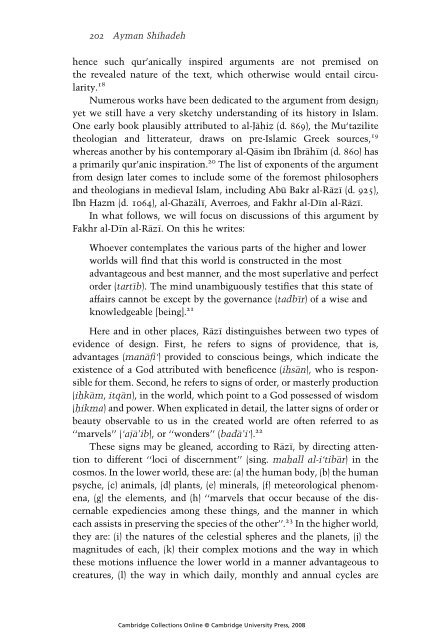Abdal Hakim Murad - The Cambridge Companion to Islamic Theology
Create successful ePaper yourself
Turn your PDF publications into a flip-book with our unique Google optimized e-Paper software.
202 Ayman Shihadeh<br />
hence such qur’anically inspired arguments are not premised on<br />
the revealed nature of the text, which otherwise would entail circularity.<br />
18<br />
Numerous works have been dedicated <strong>to</strong> the argument from design;<br />
yet we still have a very sketchy understanding of its his<strong>to</strong>ry in Islam.<br />
One early book plausibly attributed <strong>to</strong> al-Jah _<br />
iz _<br />
(d. 869), the Mu‘tazilite<br />
theologian and litterateur, draws on pre-<strong>Islamic</strong> Greek sources, 19<br />
whereas another by his contemporary al-Qasim ibn Ibrahım (d. 860) has<br />
a primarily qur’anic inspiration. 20 <strong>The</strong> list of exponents of the argument<br />
from design later comes <strong>to</strong> include some of the foremost philosophers<br />
and theologians in medieval Islam, including Abu Bakral-Razı (d.925),<br />
Ibn H _<br />
azm (d. 1064), al-Ghazalı, Averroes, and Fakhr al-Dın al-Razı.<br />
In what follows, we will focus on discussions of this argument by<br />
Fakhr al-Dın al-Razı. On this he writes:<br />
Whoever contemplates the various parts of the higher and lower<br />
worlds will find that this world is constructed in the most<br />
advantageous and best manner, and the most superlative and perfect<br />
order (tartıb). <strong>The</strong> mind unambiguously testifies that this state of<br />
affairs cannot be except by the governance (tadbır) of a wise and<br />
knowledgeable [being]. 21<br />
Here and in other places, Razı distinguishes between two types of<br />
evidence of design. First, he refers <strong>to</strong> signs of providence, that is,<br />
advantages (manafi‘) provided <strong>to</strong> conscious beings, which indicate the<br />
existence of a God attributed with beneficence (ih _<br />
san), who is responsible<br />
for them. Second, he refers <strong>to</strong> signs of order, or masterly production<br />
(ih _<br />
kam, itqan), in the world, which point <strong>to</strong> a God possessed of wisdom<br />
(h _<br />
ikma) and power. When explicated in detail, the latter signs of order or<br />
beauty observable <strong>to</strong> us in the created world are often referred <strong>to</strong> as<br />
‘‘marvels’’ (‘aja’ib), or ‘‘wonders’’ (bada’i‘). 22<br />
<strong>The</strong>se signs may be gleaned, according <strong>to</strong> Razı, by directing attention<br />
<strong>to</strong> different ‘‘loci of discernment’’ (sing. mah _<br />
all al-i‘tibar) inthe<br />
cosmos. In the lower world, these are: (a) the human body, (b) the human<br />
psyche, (c) animals, (d) plants, (e) minerals, (f) meteorological phenomena,<br />
(g) the elements, and (h) ‘‘marvels that occur because of the discernable<br />
expediencies among these things, and the manner in which<br />
each assists in preserving the species of the other’’. 23 In the higher world,<br />
they are: (i) the natures of the celestial spheres and the planets, (j) the<br />
magnitudes of each, (k) their complex motions and the way in which<br />
these motions influence the lower world in a manner advantageous <strong>to</strong><br />
creatures, (l) the way in which daily, monthly and annual cycles are<br />
<strong>Cambridge</strong> Collections Online © <strong>Cambridge</strong> University Press, 2008



